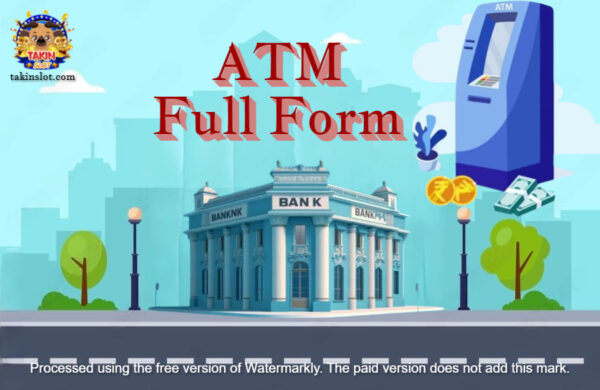Understanding ATM Machines: A Detailed Overview
ATM Full Form: ATM, or Automated Teller Machine, is an electronic device facilitating cash withdrawals and other financial transactions without the need to visit a bank branch. The term ATM stands for Automated Teller Machine, highlighting its automated nature and lack of human interaction during operation. While generally safe, using an ATM carries certain risks, including identity theft and fraud. Let’s delve deeper into how ATM machines function and the associated risks.
ATM Full Form: What is an ATM Machine?
An ATM, or automated teller machine, is a computerized electronic device designed to provide various financial services, including cash withdrawals and deposits. Utilizing an ATM requires a card embedded with a microchip, typically referred to as an EMV card (Europay MasterCard Visa). Upon insertion of the card, the ATM (ATM Full Form) prompts users to input their PIN for account authentication. Subsequently, the machine displays account information, such as balance, on its screen. Users can then select their desired transaction, such as withdrawing cash in specified denominations.
ATM Full Form: How Does an ATM Machine Work?
An ATM functions as an electronic device enabling individuals to withdraw funds from their bank accounts without visiting a physical bank branch. When using an ATM, users insert their debit or credit card into the card slot and input their unique PIN. Following authentication, the machine processes the requested transaction, deducting the specified amount from the user’s account and dispensing the corresponding cash. While ATMs offer convenience, they pose risks such as identity theft and fraud. Unauthorized access or tampering with ATMs can compromise sensitive information, leading to unauthorized transactions.
ATM Full Form: Risks Associated with ATM Usage
Despite their convenience, ATMs entail certain risks, primarily related to identity theft and fraud. Unauthorized access to ATMs, either through physical tampering or technological manipulation, can result in compromised user information and unauthorized transactions. To mitigate these risks, users should exercise caution and promptly report any suspicious activity or malfunctions observed during ATM (ATM Full Form) usage.
Advantages and Disadvantages of Using an ATM Machine
Advantages: ATM Full Form
ATMs serve various purposes in the physical world, but here we’ll focus on their virtual usage. Many individuals have interacted with ATMs to withdraw cash from their accounts.
One significant advantage of using an ATM machine for cash withdrawal is the absence of queues. This proves beneficial for individuals requiring cash regularly, as it eliminates the need to wait in long lines to access their bank accounts. Additionally, ATMs offer a convenient way for busy individuals to obtain cash when unable to visit a bank, such as during work hours or while waiting for someone. ATM Full Form
Disadvantages: ATM Full Form
Despite the convenience of withdrawing money from ATMs, there are certain drawbacks. A primary disadvantage is the lack of oversight during withdrawals, leaving users vulnerable to fraudulent activities. Without verification mechanisms in place, individuals with unauthorized access to cards can withdraw funds without the account holder’s knowledge. Moreover, ATMs present a risk of identity theft, as thieves may attempt to obtain PIN numbers or create fraudulent accounts based on user information.
Conclusion:
ATM Full Form is Automated Teller Machine. An Automated Teller Machine (ATM) is a computerized device providing banking services such as cash withdrawals, deposits, and transfers. With approximately 2 million ATMs globally, they are situated in bank branches and central locations like shopping malls.
Using an ATM machine for cash withdrawal is straightforward. Users simply need to enter their PIN, select the desired cash amount, and collect their money. The ATM also issues a receipt for record-keeping purposes.
FAQs about ATM Full Form
What does ATM stand for?
ATM stands for Automated Teller Machine. It is an electronic device that enables users to perform various financial transactions, including cash withdrawals and deposits, without the need to visit a bank branch.
How does an ATM machine work?
An ATM functions as a computerized device that interacts with users’ debit or credit cards, typically equipped with microchips known as EMV cards. Users insert their cards into the machine, authenticate themselves with a unique PIN, and select their desired transaction, such as cash withdrawal. The ATM processes the transaction, deducts the specified amount from the user’s account, and dispenses the corresponding cash.
What are the risks associated with ATM usage?
Despite their convenience, ATMs carry certain risks, including identity theft and fraud. Unauthorized access or tampering with ATMs can compromise users’ sensitive information, leading to unauthorized transactions. Users should remain vigilant and promptly report any suspicious activity or malfunctions observed during ATM (ATM Full Form) usage.
What are the advantages of using an ATM machine?
Using an ATM machine offers several advantages, such as convenience and accessibility. One significant advantage is the absence of queues, allowing users to withdraw cash quickly without waiting in long lines at bank branches. Additionally, ATMs provide a convenient option for busy individuals to access cash at any time, even outside of regular banking hours.
What are the disadvantages of using an ATM machine?
Despite their benefits, ATMs also present certain drawbacks. A primary disadvantage is the lack of oversight during transactions, leaving users vulnerable to fraudulent activities. Without proper verification mechanisms, individuals with unauthorized access to cards can withdraw funds without the account holder’s knowledge. Moreover, ATMs pose a risk of identity theft, as thieves may attempt to obtain PIN numbers or create fraudulent accounts based on user information.




